
NGC 6946, sometimes referred to as the Fireworks Galaxy, is a face-on intermediate spiral galaxy with a small bright nucleus, whose location in the sky straddles the boundary between the northern constellations of Cepheus and Cygnus. Its distance from Earth is about 25.2 million light-years or 7.72 megaparsecs, similar to the distance of M101 in the constellation Ursa Major. Both were once considered to be part of the Local Group, but are now known to be among the dozen bright spiral galaxies near the Milky Way but beyond the confines of the Local Group. NGC 6946 lies within the Virgo Supercluster.
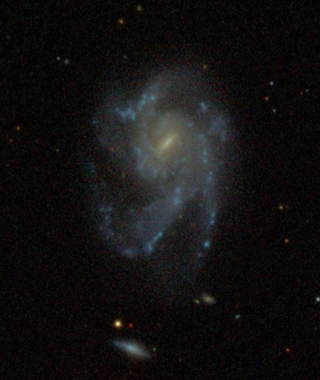
NGC 5579 is an intermediate spiral galaxy in the northern constellation of Boötes. It was discovered on May 1, 1785) by German-British astronomer William Herschel. The galaxy is located at a distance of 179 ± 14 million light-years (54.9 ± 4.3 Mpc) from the Milky Way, and is receding with a heliocentric radial velocity of 3,608 km/s. It is entry 69 in Halton Arp's Atlas of Peculiar Galaxies.

NGC 51 is a lenticular galaxy in the constellation Andromeda. It has a diameter of 90,000 light-years. The galaxy was discovered on September 7, 1885, by Lewis Swift, who described it as "Pretty faint, pretty small, round, brighter middle."

NGC 105 is a spiral galaxy estimated to be about 240 million light-years away in the constellation of Pisces. It was discovered by Édouard Stephan in 1884 and its apparent magnitude is 14.1.

NGC 6181 is a barred spiral galaxy located in the constellation Hercules. It is designated as SB(rs)c in the galaxy morphological classification scheme and was discovered by William Herschel on 28 April 1788. The galaxy is 107 million light years away.
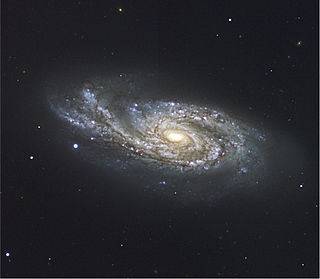
NGC 908 is an unbarred spiral galaxy in the constellation Cetus. It was discovered on 20 September 1786 by William Herschel. This galaxy is 56 million light years away from Earth. It is the main galaxy in the NGC 908 group, which also includes NGC 899, NGC 907, and IC 223.
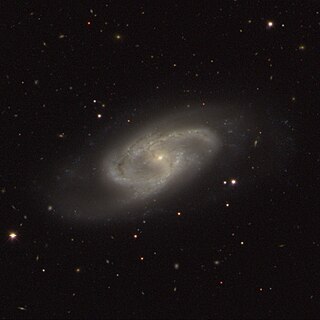
NGC 150 is a barred spiral galaxy in the constellation Sculptor. It is about 70 million light years away from the Solar System, and it has a diameter of about 55,000 light years. It was discovered on 20 November 1886, by Lewis A. Swift. The Type II supernova SN 1990K was detected in NGC 150, and was reported to be similar to SN 1987A.

NGC 198 is a spiral galaxy located in the constellation Pisces. It was discovered on December 25, 1790 by William Herschel.

NGC 213 is a barred spiral galaxy located in the constellation Pisces. It was discovered on October 14, 1784, by William Herschel.

NGC 233 is an elliptical galaxy located in the constellation Andromeda. It was discovered on September 11, 1784 by William Herschel.
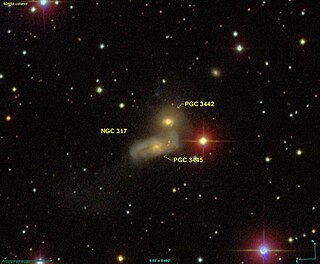
NGC 317 is a pair of interacting galaxies, consisting of a lenticular galaxy NGC 317A and a spiral galaxy NGC 317B, in the constellation Andromeda. It was discovered on October 1, 1885 by Lewis Swift.

NGC 322 is a lenticular galaxy located approximately 318 million light-years from the Solar System in the constellation Phoenix. It was discovered on September 5, 1834 by John Herschel. It was described by Dreyer as "very faint, very small, round, a little brighter middle, 3 stars to west." It apparently seems to be interacting with PGC 95427, another galaxy.

NGC 327 is a spiral galaxy in the constellation Cetus. It was discovered on September 27, 1864 by Albert Marth. It is described by Dreyer as "faint, small, extended." It is nearby galaxies NGC 329, NGC 325 and NGC 321.

NGC 392 is a lenticular galaxy located in the constellation Pisces. It was discovered on September 12, 1784, by William Herschel. It was described by Dreyer as "faint, very small, round, much brighter middle, between 2 stars."

NGC 7038 is an intermediate spiral galaxy located about 210 million light-years away in the constellation of Indus. Astronomer John Herschel discovered NGC 7038 on September 30, 1834.
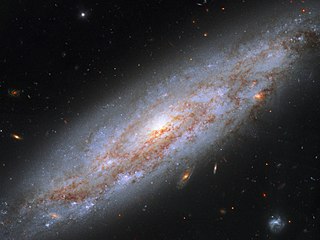
NGC 3972 is a spiral galaxy located in the northern constellation of Ursa Major. It was discovered by William Herschel on April 14, 1789. This galaxy is located 66 million light years away and is receding with a heliocentric radial velocity of 846 km/s. It is a member of the NGC 3992 Group of galaxies.
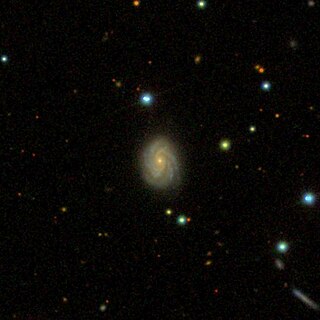
NGC 819 is a spiral galaxy approximately 302 million light-years away from Earth in the constellation of Triangulum. It forms a visual pair with the galaxy NGC 816 5.7' WNW.

NGC 812 is a spiral galaxy located in the Andromeda constellation, an estimated 175 million light-years from the Milky Way. NGC 812 was discovered on December 11, 1876 by astronomer Édouard Stephan.

NGC 644 is a barred spiral galaxy in the constellation Phoenix in the southern sky. It is estimated to be 270 million light-years from the Milky Way and has a diameter of approximately 130,000 light-years. Together with NGC 641, it probably forms a gravitationally bound pair of galaxies. The object was discovered on September 5, 1834 by John Herschel.

NGC 3172 is a lenticular galaxy located in the constellation Ursa Minor. It is the closest NGC object to the north celestial pole. Discovered by John Herschel in 1831, it is about 285 million light-years away and about 85 thousand light-years across.




















